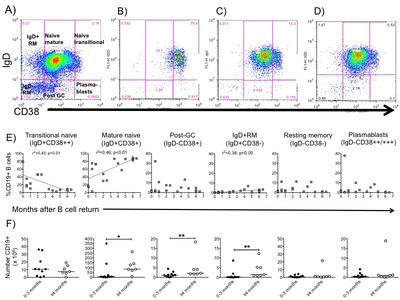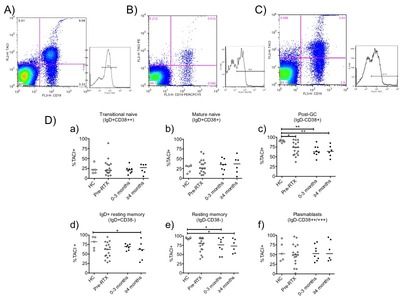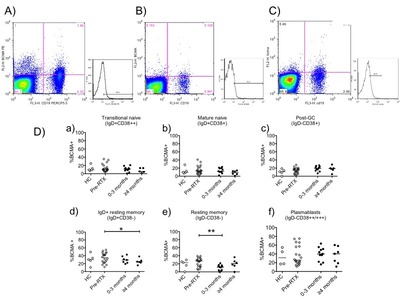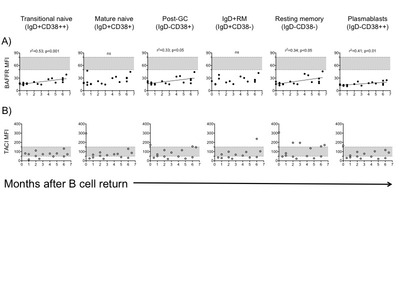Becerra, E;
De La Torre, I;
Leandro, MJ;
Cambridge, G;
(2017)
B cell phenotypes in patients with rheumatoid arthritis relapsing after rituximab: expression of B cell-activating factor-binding receptors on B cell subsets.
Clinical and Experimental Immunology
, 190
(3)
pp. 372-383.
10.1111/cei.13024.

Preview |
Text (Article)
Cambridge_CEI-2017-6498R1 untrack changes CEI May 2017 BBRs.pdf - Accepted Version Download (329kB) | Preview |
![[thumbnail of Cambridge_Slide1.jpg]](https://discovery.ucl.ac.uk/10050955/8.hassmallThumbnailVersion/Cambridge_Slide1.jpg)  Preview |
Image
Cambridge_Slide1.jpg - Accepted Version Download (139kB) | Preview |
![[thumbnail of Cambridge_Slide2.jpg]](https://discovery.ucl.ac.uk/10050955/13.hassmallThumbnailVersion/Cambridge_Slide2.jpg)  Preview |
Image
Cambridge_Slide2.jpg - Accepted Version Download (94kB) | Preview |
![[thumbnail of Cambridge__Slide3.jpg]](https://discovery.ucl.ac.uk/10050955/18.hassmallThumbnailVersion/Cambridge__Slide3.jpg)  Preview |
Image
Cambridge__Slide3.jpg - Accepted Version Download (102kB) | Preview |
![[thumbnail of Cambridge__Slide4.jpg]](https://discovery.ucl.ac.uk/10050955/23.hassmallThumbnailVersion/Cambridge__Slide4.jpg)  Preview |
Image
Cambridge__Slide4.jpg - Accepted Version Download (102kB) | Preview |
![[thumbnail of Cambridge_Slide5.jpg]](https://discovery.ucl.ac.uk/10050955/28.hassmallThumbnailVersion/Cambridge_Slide5.jpg)  Preview |
Image
Cambridge_Slide5.jpg - Accepted Version Download (91kB) | Preview |
![[thumbnail of Cambridge__Slide6.jpg]](https://discovery.ucl.ac.uk/10050955/37.hassmallThumbnailVersion/Cambridge__Slide6.jpg)  Preview |
Image
Cambridge__Slide6.jpg - Accepted Version Download (71kB) | Preview |
Abstract
Serum levels of B cell‐activating factor (BAFF) rise following rituximab (RTX) therapy in patients with rheumatoid arthritis (RA). Initiation of naive B cell return to the periphery and autoreactive B cell expansion leading to relapse after RTX may therefore be linked to interactions between BAFF and BAFF‐binding receptors (BBR). Relationships between serum BAFF and BBR expression [(BAFFR, calcium signal modulating cyclophilic ligand interactor (TACI) and B cell maturation antigen (BCMA)] were determined on B cell subsets, defined using immunoglobulin (Ig)D/CD38. Twenty pre‐RTX and 18 RA patients relapsing after B cell depletion were included. Results were analysed with respect to timing of relapse up to 7 months after peripheral B cell return (≥ 5 B cells/μl) and to serum BAFF levels. After B cell return, B cell populations from relapsing patients had significantly lower BAFFR+ expression compared to HC and pre‐RTX patients. The percentage of BAFFR+ B cells increased with time after B cell return and was correlated inversely with serum BAFF levels. BAFFR expression remained reduced. The percentage of TACI+ memory B cells were lower in RA patients after RTX compared with healthy controls (HC). BCMA expression (% and expression) did not differ between patients and HC. Relapse following B cell return appeared largely independent of the percentage of BAFFR+ or percentage of BCMA+ B cells or serum BAFF levels. The lower percentage of TACI+ memory B cells may reduce inhibitory signalling for B cell differentiation. In patients relapsing at longer periods after B cell return, recovery of the B cell pool was more complete, suggesting that selection or expansion of autoreactive B cells may be needed to precipitate relapse.
| Type: | Article |
|---|---|
| Title: | B cell phenotypes in patients with rheumatoid arthritis relapsing after rituximab: expression of B cell-activating factor-binding receptors on B cell subsets |
| Open access status: | An open access version is available from UCL Discovery |
| DOI: | 10.1111/cei.13024 |
| Publisher version: | http://doi.org/10.1111/cei.13024 |
| Language: | English |
| Additional information: | This version is the author accepted manuscript. For information on re-use, please refer to the publisher’s terms and conditions. |
| Keywords: | B lymphocytes, rheumatoid arthritis, rituximab |
| UCL classification: | UCL UCL > Provost and Vice Provost Offices > School of Life and Medical Sciences UCL > Provost and Vice Provost Offices > School of Life and Medical Sciences > Faculty of Medical Sciences UCL > Provost and Vice Provost Offices > School of Life and Medical Sciences > Faculty of Medical Sciences > Div of Medicine UCL > Provost and Vice Provost Offices > School of Life and Medical Sciences > Faculty of Medical Sciences > Div of Medicine > Inflammation |
| URI: | https://discovery.ucl.ac.uk/id/eprint/10050955 |
 Loading...
Loading... Loading...
Loading... Loading...
Loading... Loading...
Loading...Archive Staff Only
 |
View Item |




